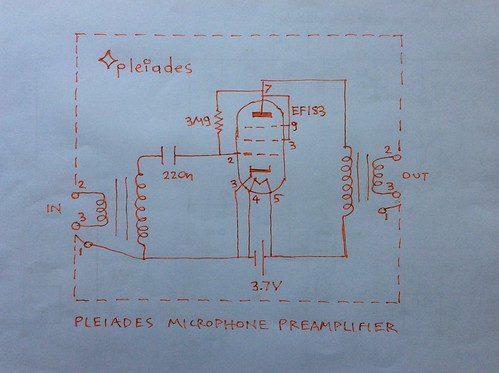Continued from:
http://euroelectron.blogspot.com/2018/08/ef183-open-grid-as-mic-booster-with-10v.html
The schematic is:

but with Cc=22nF and a 9V battery in series with a fuse for safety powering the anode circuit.
The grid is open (no pull up bias resistor).
When the grid is open the output from this Pleiades V6 mic booster amplifier is very low noise. (the ticking clock can be heard at the far away room through the headphones through all the ambient noise and some hiss). Before connecting anything to the input the output is still low noise. The input transformer is now unplugged as well....
There is almost dark, velvet soft silence. It reminds of a Neumann U47, the noise floor sound of VF14 with the condenser capsule unplugged.
If a link is connected between ground or cathode and the input capacitor there is not much change. There is not much change in noise between 0Ω and almost infinite input. In fact it is not infinite, there much be the input capacitance [Meyer].
The anode current today is 30μA possibly because of reduced heater voltage supply to heaters from somewhat exhausted 3 AA batteries.
When 18MΩ is connected between grid and cathode or ground the anode current due to pull up bias from the positive cathode jumps to 70-100μA. Gain goes up. Hiss goes up. When an 0Ω link is connected hiss goes way down.
If then the 18MΩ resitor is removed, plate current goes back to 30μA and the hiss does not change from way down. It is still as low. When the short circuit link between the cathode or ground and input capacitor is removed the hiss is slightly increased. Very interesting.
When the Altec transformer is pluged in hiss increases.
When the Sennehsier MD441 U3 mic is pluged in there a big ambience sound, the mic acting like a vacuum hoover collecting sound from everywhere.
At 30μA the sound of singing voice is big. Mic distance has to be greater than 10in to avoid extra bass heaviness. The room acoustics do not help.
What is the potential at the grid? The open grid. The space potential?
The usual YFE multimeter was connected between ground or cathode and grid and as it was connected to grid the anode current jumped to much higher. This means the digital voltmeter changes the grid potential by its non infinity internal resistance. It's finite resistance (1GΩ?) pulls up bias from the positive cathode. (Cathode is positive as it is missing electrons by thermionic emmision).
So next a Metrohm pH meter was connected as a voltmeter. The anode current did not change, very good news, and a reading of -500mV could be taken. Possibly the most accurate measurement so far.
Then the anode potential supply was disconnected and the grid potential slowly increased to -700mV ie pH14. (as seen by the meter needle and number scale 0V is 7pH, 700mV is pH0. So -700mV, this is how negative the grid becomes by just applying a heater voltage of 3.9V to the EF183 electron tube.
Then for the sake of curiosity a passive analog voltmeter was connected. It read only -20mV.
Thumps up to Metrohm Switzerland for their nice electron tube electrometer. The pH-meter Metrohm Herisau E350B.
Reference:
Open grid tubes in low level amplifiers - Robert J. Meyer - electronics - October 1944 - McGraw Hill
No comments:
Post a Comment